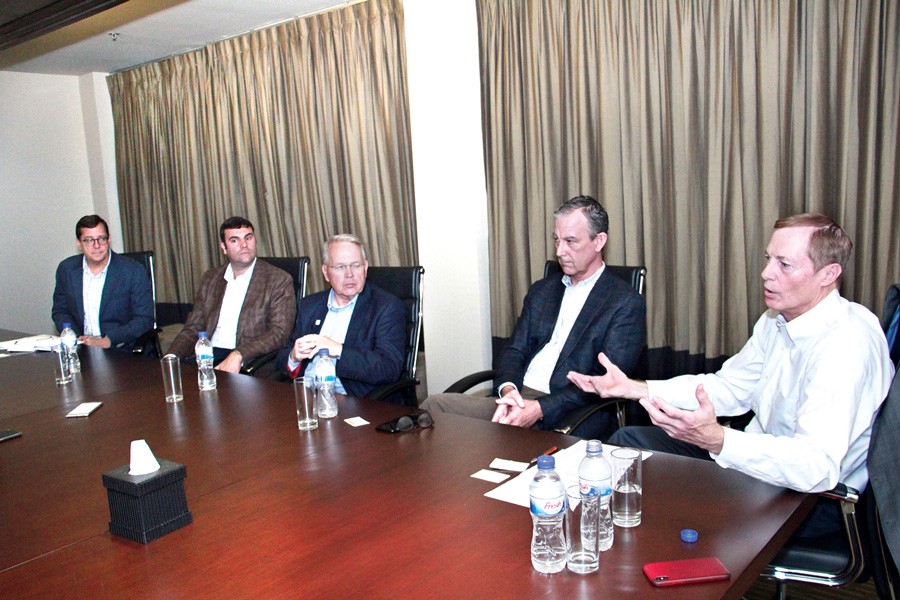 Members of a US cotton industry delegation talking to reporters at a city hotel on Wednesday. From right are Executive Director of Cotton Council International (CCI) Bruce A Atherley; First Vice Chairman of ACSA William Barksdale; representative of US cotton producers Mark Nichols; Vice President, supply chain marketing, Asia, Cotton Incorporated, William D Kimbrell; and Director, supply chain marketing, South and Southeast Asia of CCI William R Bettendorf
Members of a US cotton industry delegation talking to reporters at a city hotel on Wednesday. From right are Executive Director of Cotton Council International (CCI) Bruce A Atherley; First Vice Chairman of ACSA William Barksdale; representative of US cotton producers Mark Nichols; Vice President, supply chain marketing, Asia, Cotton Incorporated, William D Kimbrell; and Director, supply chain marketing, South and Southeast Asia of CCI William R Bettendorf US cotton traders seek to raise their market share in Bangladesh by 33 per cent in the next five years, buoyed by the growing textile industry, especially the spinning sector, which largely depends on imported cotton.
They also urged the Bangladesh government to scrap the age-old fumigation rules on the import of US cotton to save both time and money and to increase the flow of quality cotton supply.
"The US has grabbed 11 per cent of Bangladesh's total cotton import last year and the share actually increased three times since 2015," said executive director of Cotton Council International (CCI) Bruce A Atherley, now visiting Dhaka.
Bangladesh imported 7,85,000 bales of cotton from the US in 2018, up from 2,26,000 bales in 2015, he said.
"We want to grow here three times further by 2024," he added.
Mr Atherley is leading a high-level US cotton industry delegation that came to Dhaka on the occasion of fourth Bangladesh Cotton Day observed on Wednesday.
The Cotton Council International marked the day with a programme at a city hotel.
The US delegation members talked with a selected group of reporters on the sidelines of the cotton day celebrations.
Bangladesh, a market of 2.0 million cotton bales, is very important for the US traders due to the spectacular growth of its textile industry over the last 20 years, said Mr Atherley.
Moreover, Bangladesh's spinning industry is heavily dependent on imported cotton and the country tops the list of nations dependent on imported cotton, he noted.
Bangladesh imported the highest quantity of cotton from around the world during the period from 2015 to 2018, he said.
Although China now becomes the largest importer of cotton, Bangladesh, being the second largest cotton importer, is still important and a large market for US cotton, he added.
Bangladesh imported 8.2 million bales of cotton in 2018, according to Bangladesh Textile Mills Association.
Some 37.06 per cent of the total cotton bales was imported from Africa, 26.12 per cent from India, 11.35 per cent from the Commonwealth of Independent States (CIS) countries, 11.14 per cent from the US, 4.65 per cent from Australia, and 9.65 per cent from other countries.
The US industry traders noted that the US can supply more reliable and high quality cotton to Bangladesh spinners.
They believe that consumption of cotton in Bangladesh will increase further due to the growing demands for natural fibres across the globe.
"We see a continuing demand for cotton worldwide and Bangladesh is perfectly in the position to take advantage of this," said Mark Nichols, who represents the US cotton producers.
Apparel brands and retailers are shifting to other countries from China due to ongoing trade war between the US and China, he said, adding that countries like Vietnam, Cambodia, Indonesia and Bangladesh could get benefits from this issue.
"And Bangladesh having the world renowned cotton spinning expertise is prospective for us," Mr Nichols said.
About fumigation rules, William R Bettendorf, director, supply chain, marketing for South and Southeast Asia of CCI, said they have been pressing Bangladesh authority to withdraw the double testing provision, but the issue still remains unresolved.
The fumigation procedure puts unnecessary and additional cost burden on local importers, he said, adding that fumigation is unnecessary as US cotton is harvested in such a way that kills 'boll weevil'.
There is no reason for fumigation at the Chittagong Port, as major markets like China and Vietnam don't waste money on unnecessary fumigation, he said.
Echoing his view, Mr Nichols said though US cotton is costly, it has lower cost at the end of production side because of its quality and reliable supply.
Responding to a question, Mr Atherley pointed out that geographical distance that makes US cotton expensive and marketing and educating the local spinners about the benefits of US cotton are other major challenges.
Explaining their marketing strategy, William D Kimbrell, vice president at Cotton Incorporated, said they put much focus on products and fabrics development and innovation.
They also give forecast on colour and fabric to their registered spinners, he added.
munni_fe@yahoo.com
© 2026 - All Rights with The Financial Express
